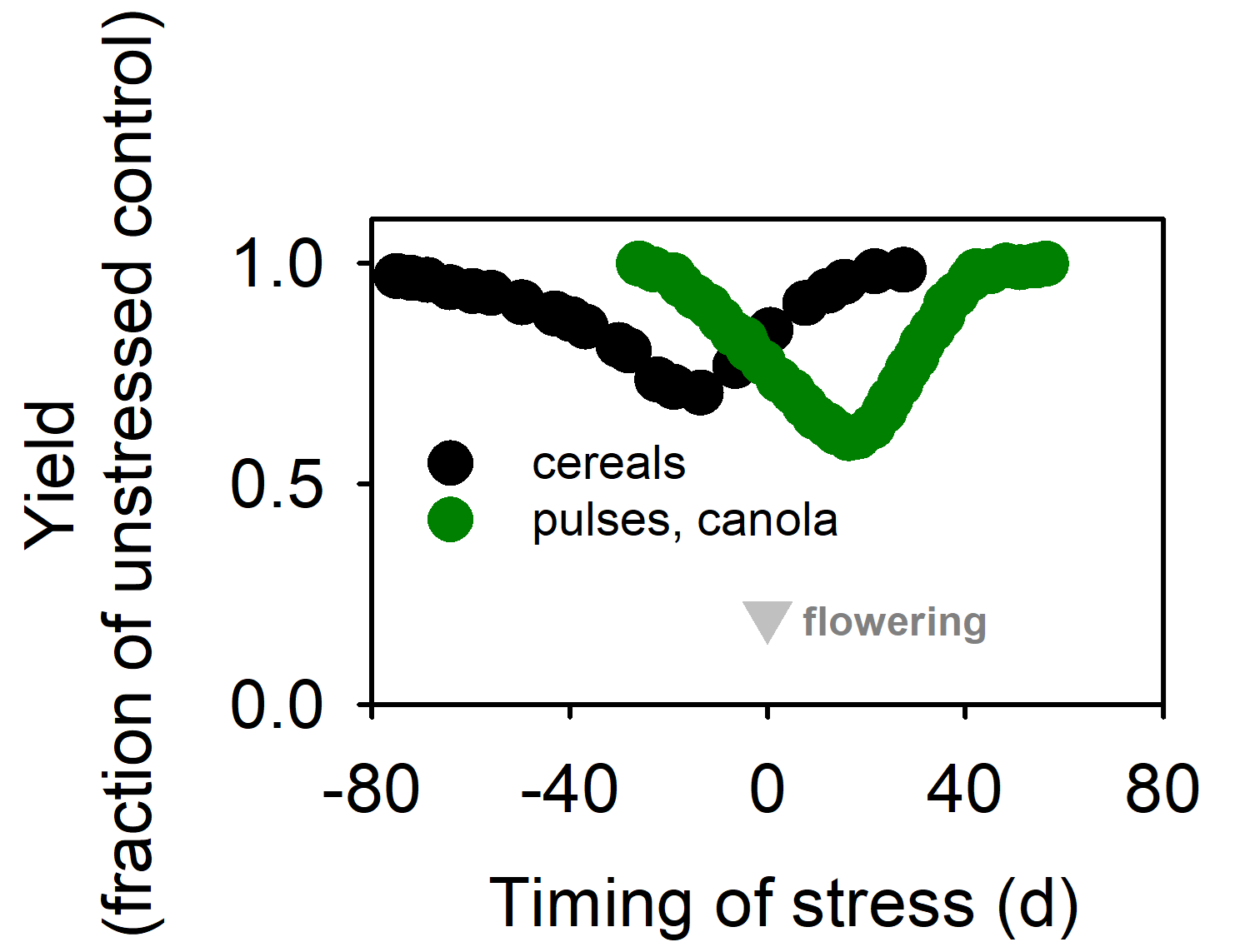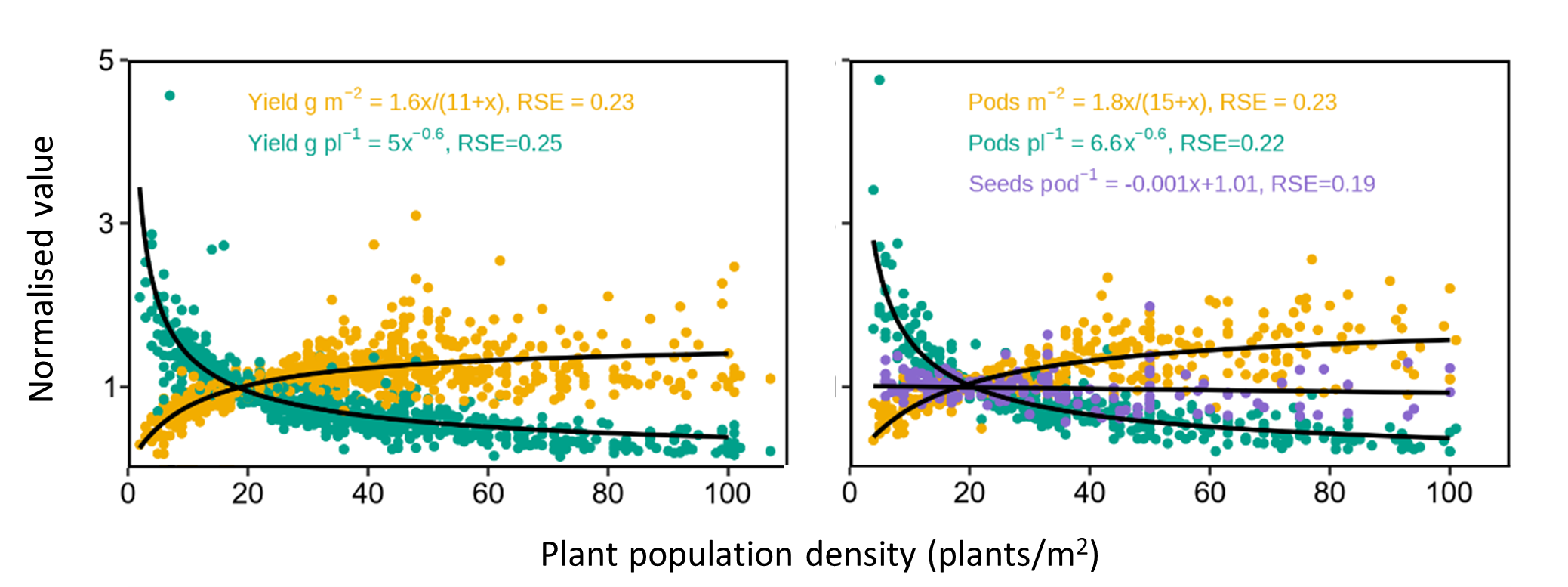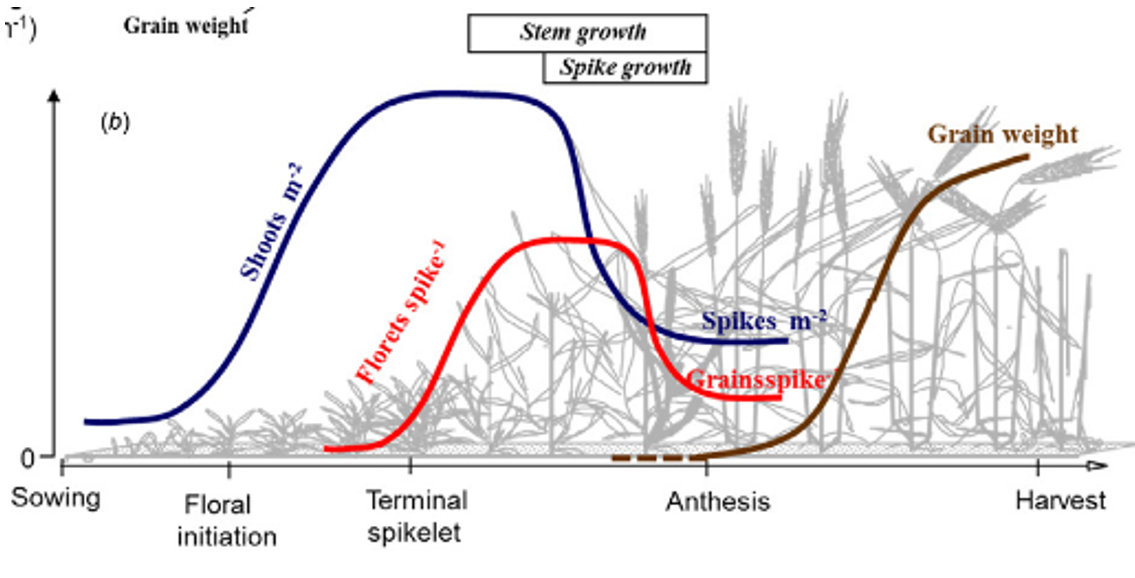Pod-set in faba bean – benchmarks and physiology
Pod-set in faba bean – benchmarks and physiology
Author: James Manson (University of Adelaide), Victor Sadras (University of Adelaide, South Australian Research and Development Institute) | Date: 06 Feb 2024
Take home messages
- Pod number can be used to estimate grain yield in southern Australia: every 100 pods/m2 (that contain grain at maturity) equate to approximately 1t/ha for cultivars released since 2013.
- Grain yield, grain number and pod number are associated with growth during the critical period, which is at pod emergence in faba bean.
- Pod-set is highly coordinated across a faba bean plant, so avoid drawing conclusions from pod numbers at individual nodes.
Background
Increased profitability of faba bean in Australian farming systems can be achieved through an increase in grain yield, grain price or both, and/or a reduction in production cost. This paper will focus on grain yield. Grain yield is correlated with pod number, and over several weeks faba bean plants produce many flowers but most do not set a pod. This has led industry and researchers to identify ‘pod-set’, that is, the successful conversion of flowers into pods that contain marketable seeds at maturity, as a target for crop improvement. Physiological theory and evidence can provide clarification on the significance of this trait.
Physiological theory explains yield in terms of crop behaviour, which complements agronomic theory that explains yield in terms of grower management. Agronomic theories are practical, but relying on them solely does not account for the inherent crop response that generates the observable traits that we measure, such as pod-set. Understanding of the underlying crop physiology helps growers ensure the agronomic theories and practices used are appropriate for the given crop.
In this update paper, we will:
- provide a benchmark for faba bean grain yield from pod number
- outline the key drivers of grain yield and pod-set at the crop, plant and node levels
- use this knowledge to address frequently asked questions in a physiological context.
Key concept: life is organised by scale
To explain faba bean pod-set systematically, let’s start by acknowledging that biological units are organised in a hierarchy of scales: cells within tissues within organs within individuals within populations, and so on (Figure 1). In a cropped paddock, the crop is the population level, the plants occupy the individual level, and the flowers, pods, leaves, and other structures occupy the organ level.

Figure 1. Life is organised by a hierarchy of scales. Source: Sadras and Richards 2014.
It is important to think about scales explicitly to define our terms. When ‘yield’ is defined as tonnes of grain harvested per hectare, this is a crop (population) trait. Pod-set can be described at both crop (pods/m2) and plant (pods/plant) scales.
It is also important to think about how higher and lower scales relate to each other. For example, behaviours of plant organs (flowers, pods) are coordinated by the plant as a whole, so it is expected that pod-set will be connected to other plant functions. Furthermore, plants compete and/or cooperate, so it is expected that plant interactions are a factor for crop-level growth and reproduction.
The next sections work through crop, plant and organ scales to explain pod-set.
Results and discussion
Grain yield and pod-set at the crop scale
Most of the variation between high and low grain yields associates with variation in grain number (grains/m2). This has frequently been shown in cereals, oilseeds and pulses, and holds true across climates, soils and management (Figure 2). It is also true for faba bean (Figure 3a), where pod number shows a similar, but more scattered, correlation with yield (Figure 3b). This shows that faba bean crops are responding to good and bad conditions mostly by changing these traits. Grain weight (mg/seed) has a small effect and is important for grain quality and some agronomic scenarios (for example, decisions for late-season crop inputs), but grain number is key for yield variation.

Figure 2. Crop yield is primarily related to grain number. Source: Sadras 2021.

Figure 3. Grain yield is related to (a) grain number and pod number in faba bean. The cultivars are PBA Amberley, PBA Bendoc, PBA Samira and PBA Zahra, and management sources of variation include plant density, sowing date and row spacing. Data are from (a) nine or (b) 12 disease-free site-years, and two (a, b) moderately diseased site-years in southern Australia.
Grain number is determined during a ‘critical period’, during which a change in growth has a large effect on grain number and yield, and outside of which a change in growth has a smaller effect on yield. The critical period is during booting in cereals, and centres on pod emergence in pulses and canola, including faba bean (Figure 4). Yield could be increased by a longer critical period (for example, better matching of phenology to the environment), faster growth during the critical period (for example, adequate groundcover to capture all radiation) and greater allocation to seeds during the critical period (for example, more efficient genotypes). At the end of a season when interpreting pod number and/or grain yield achieved, the key question to ask is ‘What happened during the critical period?’ Then, the answer to this question can be linked to other factors for yield (see the FAQs section below for examples).

Figure 4. Species-specific critical windows for grain number and yield. Source: Sadras and Dreccer 2015.
Pod-set at crop and plant scales
Since grain yield was defined as a population trait above, we are only interested in yield per plant if it is correlated with yield per hectare, and this is not always the case. For example, when plant population density changes in response to sowing rate or crop establishment, crop yield and plant yield move in opposite directions (Figure 5a). The same is true for pod number (Figure 5b).

Figure 5. Faba bean crop and plant responses of (a) yield and (b) pod number to plant population density, from a database of 204 responses (126 of which are from Australia). Traits are normalised by their value at 20 plants/m2 (for example, ‘3’ is three times larger than the response’s 20 plants/m2 value). Yellow symbols are traits with area-based units (/m2), green symbols have units of /plant1, and purple symbols have other units. Curves are Michaelis-Menten models for /m2 traits, power models for /plant traits, and a linear model for seeds/pod. RSE is residual standard error of the normalised trait.
When plant population density is the same across seasons, pods/m2 and pods/plant are correlated. However, plant density can vary between seasons and within a paddock so pods/m2 is the most reliable indicator for yield estimation. Figure 3b showed that in the southern region, approximately every 100 pods/m2 is roughly equivalent to 1t/ha of grain yield for cultivars released since 2013 (PBA Samira). Pods should be counted from a measured area, or converted from pods/plant using the plant density where the count was taken. The estimate could be performed during late pod-set, when growers are confident they can identify the pods that are likely to reach maturity.
Pod-set at plant and node scales
Faba bean plants have a distinct pattern of pod distribution along the stems that can be described as ‘pear-shaped’ or ‘bottom-heavy’. The first panel of Figure 6 (‘1Control’) illustrates this pattern in a typical faba bean crop, PBA Samira grown at Freeling, SA in 2022 at 25 plants/m2. After a few failed flowering nodes, most pods are formed on the lower, older flowering nodes with a sharp decrease in pods for younger nodes higher on the stem. This basic shape is universal in faba bean; it applies across widely different soils, climates and genotypes. Panels 2, 3 and 4 of Figure 6 show that when the crop was thinned from 25 plants/m2 to 5 plants/m2, giving each plant much greater access to light and water, it was the lower nodes that responded, even as late as grain-fill. In the field, do not assume that pod number at an individual node reflects an isolated event because these findings show that pod-set is coordinated by the whole plant and the responsiveness of the nodes overlaps significantly.

Figure 6. Vertical distribution of pods along faba bean main stems, grown at Freeling, SA in 2022. Panel 1) Control, PBA Samira, 25 plants/m2. Panel 2) Thinned to 5 plants/m2 at flowering. Panel 3) Thinned at pod emergence. Panel 4) Thinned during early grain-fill. Points are the mean of three replicates, four plants per replicate.
The pattern of faba bean pod-set within a plant is an example of how all flowering plants reproduce. Flowering plants overproduce flowers and cull them according to a range of factors, such as resources, pollination status, and so on. One estimate for faba bean is that if every ovule in every flower formed a normal-sized seed, it would equate to a yield of 38 t/ha. Overproduction of florets occurs in wheat, too, but it isn’t visible (Figure 7, red line).

Figure 7. Generation of yield components over time in wheat. Source: Slafer et al. 2014.
It is also common for a hierarchy to develop among growing offspring on a plant where some seeds are larger and/or more likely to develop to maturity - a phenomenon called ‘dominance’. This would explain the vertical distribution of pods in faba bean: the older, larger pods dominate the younger, smaller ones, including when plant resources are increased during reproduction. Experiments on faba bean in 2023, where the first flowers or first pods were removed, showed that younger nodes higher on the stem can form pods to compensate for lost pods lower down the stem. This suggests that the pattern of pod-set in faba bean is partially the result of a buffering system that can accommodate some pod abortion earlier in the season.
Pod-set FAQs
With this physiology in mind, we can address some frequently asked questions about faba bean pod-set. Given the importance of critical period growth to grain yield, it will help to distinguish growth-dependent effects from growth-independent effects.
How does self-shading influence pod-set?
Some self-shading always occurs in plants, but excessive self-shading might lead to reduced growth during the critical period, with the plants aborting more flowers as a result (a growth-dependent effect). Alternatively, the altered light conditions might signal the plant to conservatively abort flowers (a growth-independent effect), leading to a ‘de-coupling’ of crop growth rate and yield, as has been observed in field pea. The reasons lead to different research pathways to find solutions, and the measurements have been taken in field trials 2022 and 2023 to distinguish them.
However, during the triple La Niña events of recent years, where rainfall and growth were higher than average and radiation was lower than average, pod-set and yields were high where disease was kept under control. This would suggest that moisture supply is an important factor that may be the true cause of an apparent de-coupling of growth and yield. Further research is required, but in the meantime, care should be taken to distinguish self-shading from lodging and disease effects in seasons with high biomass.
How does diseases influence pod-set?
Faba bean diseases, such as chocolate spot, affect both leaves and flowers. Loss of photosynthetic area could increase flower abortion (growth-dependent effect), while diseased flowers might be killed (growth-independent effect). The same solution applies in either case: practice integrated disease management.
How does insect pollination influence pod-set?
Pollination may increase faba bean pod-set and yield, but the results are inconsistent. Both fully self-pollinating and partially pollinator-dependent genotypes have inconsistent responses to pollination. In some seasons, growth during the critical period might not be sufficient for pollination to show a large effect (growth-dependent effect). Pollination can even lead to pod abortion, because sometimes pollen grains clog the stigma, leading to flower abortion (growth-independent effect).
Pollinator numbers are declining worldwide, which has been shown to cause some plant species to become more reliant on self-pollination, and this could be the case for faba bean. Furthermore, in the first stages of the Australian breeding program, plants are kept in bee exclusion cages to eliminate cross-pollination, so there is some selection pressure for self-pollination.
If beehives can be placed near faba bean crops at an acceptable cost, then this can be seen as an insurance against unnecessary losses, but it is unlikely to be a major driver of grain yield in Australian conditions.
How does heat stress influence pod-set?
Heat stress is a major constraint to faba bean production. It could reduce yield by shortening growth during the critical period or reducing its growth rate, leading to reduced pod-set (growth-dependent effect). It can also disrupt normal reproductive functions, such as causing pollen sterility (growth-independent effect). The difference has breeding implications, but for growers the same strategy of timely sowing is required.
Conclusion: should we focus on pod-set to improve faba bean grain yield?
Expanding faba bean production into lower rainfall areas might require an increase in both biomass and harvest index. However, in the higher rainfall regions where they are grown most, faba bean crops can, and often do, produce large amounts of biomass and are prone to diseases and lodging. For these environments, increasing faba bean grain yield through increased harvest index is preferable. This will require either an increase in pods per plant or seeds per pod (not discussed in this paper, but similar principles apply).
However, the need for greater harvest index does not automatically imply that flower, pod or seed ‘failure’ is the problem that requires specific attention. A range of growth-dependent and growth-independent factors contribute to pod-set in faba bean, and the growth-independent effects are inconsistent (pollination), require more research (self-shading), or do not change grower practice (disease, heat). Consequently, growers should focus on the key drivers of yield: matching phenology and growth during the critical period to their target environments and protecting the crop from diseases and weeds.
Acknowledgements
The research undertaken as part of this project is made possible by the significant contributions of growers through both trial cooperation and the support of the GRDC. The authors would like to thank them for their continued support. James’ PhD is supported with a GRDC Research Scholarship.
References
Sadras VO (2021) Evolutionary and ecological perspectives on the wheat phenotype. Proceedings of the Royal Society B: Biological Sciences, 288, 20211259
Sadras V, Dreccer MF (2015) Adaptation of wheat, barley, canola, field pea and chickpea to the thermal environments of Australia. Crop and Pasture Science, 66, 1137-1150.
Sadras VO, Richards RA (2014) Improvement of crop yield in dry environments: benchmarks,
levels of organisation and the role of nitrogen. Journal of Experimental Botany, 65, 1981-1995.
Slafer GA, Savin R, Sadras VO (2014) Coarse and fine regulation of wheat yield components in response to genotype and environment. Field Crops Research 157, 71-83.
Faba bean southern region – GrowNotes™
Manson J, Sadras V, Brand J (2022) Yield response to plant density in faba beans: management and profitability implications. GRDC Bordertown Update
Contact details
James Manson
2c Hartley Grove, Urrbrae SA 5064
james.manson@adelaide.edu.au
@TrialsofJManson
GRDC Project Code: UOA2202-006RSX, UOA2204-004RTX,
